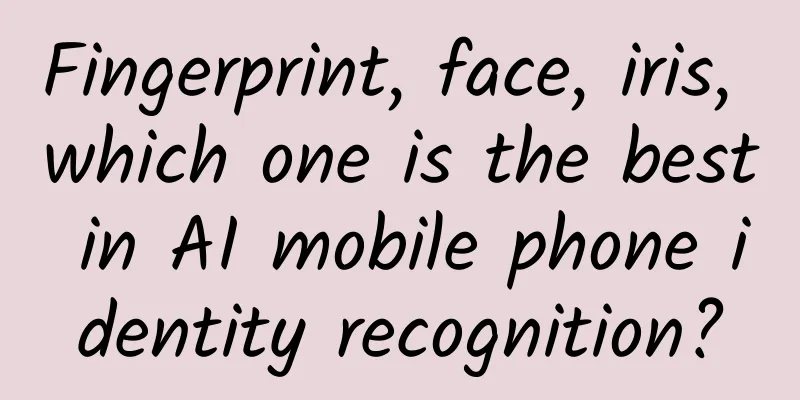Fingerprint, face, iris, which one is the best in AI mobile phone identity recognition?

|
There are no two identical leaves or people in the world, and biometric technology has many uses. Three opportunities make biometric technology a new favorite in smartphones Biometrics is not a new technology. It is a technology that uses the inherent physiological characteristics of the human body to identify individuals. It has been put into commercial use in the last century, but it has only been widely used in smartphones in the past two or three years. The mainstream biometrics technologies used in mobile phones on the market are fingerprint recognition, face recognition, and iris recognition. According to market research data from the Communications Industry News, in the first half of 2018, the top 10 mainstream flagship smartphones including Apple (Samsung S9, Huawei P20 Pro, Honor 10, iPhone 8, Meizu 15 Plus, Nut R1, OnePlus 6, Xiaomi 8, vivo NEX, OPPO Find X.) all adopted biometrics.
It has only been five years since Apple released the iPhone 5s in September 2013, and biometrics has flourished on a large scale in the smartphone field. There are three reasons for this. First, the technical bottleneck has been broken. The development of fingerprint recognition, face recognition and iris recognition technology can be traced back to the last century. They have long been used in banking, social welfare security, e-commerce, security and defense, but due to the inability to miniaturize sensors and material limitations, they have not been applied to mobile phones. In recent years, with the miniaturization of sensors required for press-type, capacitive and under-screen fingerprint recognition, 3D face recognition and iris recognition, and the increasing maturity of technical solutions such as face recognition and iris recognition, coupled with the increase in the size of smartphones, more space has been provided for the installation of sensors, which has finally enabled biometric technology to be installed on smartphones. Secondly , the large-scale application of biometric technology in smartphones is inseparable from the stimulation of market demand. Although the smartphone market is a hot market, the demand for mobile phones with biometric functions is still strong. According to a survey by Acuity Market Intelligence, nearly two-thirds of new smartphones in 2017 have biometric capabilities. It is expected that the penetration rate of biometric technology in new smartphones will reach 100% in 2019. Around 2022, the number of mobile devices using biometrics in the world is expected to reach 5.5 billion, and the penetration rate of biometric technology in wearable devices and tablets will also reach 100%. With the huge demand of the 100 billion smartphone market, the market demand for smartphones equipped with biometric technology will also be very large. Third, finding new development points for mobile phones is the top priority for mobile phone manufacturers, and the huge market demand for mobile phones with biometric technology is a new opportunity for the development of smartphones, so biometric mobile phones are strongly sought after by manufacturers. After the rapid development of smartphones, the upgrade range of smartphones has become smaller and smaller due to hardware bottlenecks, and the selling points of new smartphones have become fewer and fewer, which has reduced the purchasing desire of users. In order to enhance the purchasing desire of users, smartphone manufacturers are eager to find new selling points. Biometric technology is becoming more and more mature and popular in the market. It has the conditions to become a new selling point for smartphone manufacturers' new smartphones. After being promoted by smartphone manufacturers, biometric technology has gradually become a must-have function of smartphones. Why biometrics are attractive for smartphones Fingerprint recognition technology has become a standard feature of smartphones since the release of iPhone 5s in 2013; after the release of Samsung NOTO 7 in 2016, iris recognition provided another biometric solution for smartphones; after the release of iPhone X in 2017, face recognition became a new trend for smartphones. Now, both high-end flagship phones and 100-yuan phones have biometric recognition technology. Why do smartphones love biometric recognition technology so much? First, it is highly secure, convenient and fast. The security of biometrics is much higher than that of traditional pattern unlocking and password unlocking. Because the biological characteristics of the human body are unique, immutable, and identifiable, they are safer and more confidential than traditional mobile phone passwords or patterns. Currently, the three biometric technologies on the market are difficult to crack. In contrast, the traditional mobile phone unlocking method only requires peeping or other means to steal the password and decipher it, which is slightly less secure than biometric mobile phones. Second, users pursue a better quality of life. In the 1G era, users’ demand for mobile phones was only to make calls; in the 2G era, it changed to text messages and social software; in the 3G era, it rose to the level of pictures and texts; in the 4G era, people have “moved” almost everything from eating, living, traveling, shopping and entertainment into their mobile phones, which will generate a large amount of private data. At this time, the emergence of biometric technology just meets people’s needs for data security in these aspects. In addition, in the “fast era”, everything is fast, and biometrics can unlock the phone in as little as 0.1 seconds. The convenient and fast characteristics also meet the user’s pace of life. What are the capabilities of the three major biometric technologies? Today, biometric technology has been widely used in the field of smartphones, and fingerprint recognition, face recognition and iris recognition have formed a three-legged situation. All three biometric technologies are remarkable, but in 2017, there was a significant increase in smartphones using facial recognition technology. So is facial recognition technology the final solution for smartphone biometrics? If you want to know what is going on in the mountains, you need to ask the mountain people. If you want to know the final solution for smartphone biometrics, you need to make a specific analysis. Fingerprint recognition Fingerprint recognition has the advantages of fast speed, high accuracy and low cost. Meizu mobile phone is the first domestic mobile phone to adopt fingerprint recognition function, and has many years of experience in fingerprint adjustment. Taking Meizu 16 as an example, its under-screen fingerprint design has an unlocking speed of 0.2s when the screen is on, which is significantly faster than the traditional 6-digit password unlocking of 1.2s, nine-square pattern unlocking of 0.7s, facial recognition unlocking of 0.4s and iris recognition unlocking of 2s, and the accuracy rate has also reached 99%. In addition, since the Meizu 16 uses an under-screen fingerprint solution that has not yet been widely used, its production cost is only slightly higher than that of mobile phones that use facial recognition and iris recognition solutions. However, the production cost of the fingerprint module of a mobile phone that uses ordinary fingerprint recognition is almost less than one-third of the 3D facial unlocking recognition module and one-fifth of the iris unlocking recognition module. Ordinary fingerprint recognition also has advantages in production costs. However, fingerprint recognition is not very safe as a mobile phone token, because when using fingerprint recognition to unlock, the fingerprint collection sensor needs to come into direct contact with the human body, which will inevitably leave fingerprint information on the phone. Fingerprint information is easy to steal and forge, and the security is still poor. In addition, smartphones need to install sensors to realize fingerprint recognition function. In the era of full-screen phones, there is almost no extra space on the front panel of the phone to add fingerprint recognition sensors. The main solution to increase the biometric recognition function of the phone is to put the fingerprint recognition sensor on the back of the phone like Huawei P20, Xiaomi Mix and other mobile phones, but this will reduce the appearance and integrity of the phone. Facial Recognition Smartphones that use facial recognition technology have the advantage of being more convenient and faster to unlock. Since the release of iPhone X, the number of facial recognition phones has been increasing. Take Xiaomi 8, which also uses 3D structured light facial recognition technology, for example. The 3D structured light technology used by Xiaomi 8 can complete the unlocking process the moment the face is aligned with the screen, and can also be used in special scenarios such as when the user's hands are wet or not empty, making unlocking very convenient and fast. But it has the disadvantage of high cost. According to Xiaomi's usual style, the price of the flagship Xiaomi series has always been 1999, but this year the price of Xiaomi 8 has reached 2699. In addition to the price increase of processors and memory this year, the high cost of 3D structured light sensors is also an important factor causing the price increase of products, so the cost of face recognition is still relatively high. Iris Recognition The biggest advantage of iris recognition is its high security and accuracy. Currently, the most representative product using iris recognition is Samsung Noto 8. During verification, the iris recognition sensor does not need to come into contact with the human body, and the iris will only appear when exposed to infrared light, so the chance of the iris being stolen is very small, which ensures high security. The accuracy is due to the fact that iris recognition can identify more than 260 feature points on the iris of the eye, and can achieve an almost 100% recognition rate. But the disadvantages are also very obvious, such as high cost and cumbersome operation steps. Samsung Noto 8 uses iris recognition in a full-screen design, so it has to customize a high-quality infrared camera that can be installed on the front panel of the phone and can recognize irises, because there is almost no space on the front panel of the phone to install the sensor, which increases the overall cost of the phone. In addition, the iris recognition steps of Samsung Noto 8 are cumbersome. You need to light up the screen first and then put your eyes in the designated area for the phone to recognize before you can complete the unlocking. The whole process takes nearly 2 seconds, which makes the recognition speed very slow. summary The three biometric technologies are all popular in the field of smartphones, but it is undeniable that all three biometric technologies have a common shortcoming, that is, the lack of functionality. From this perspective, none of the three is the best choice for smartphones in the field of biometrics. But if we choose the best partner for smartphones from the existing biometric technologies, in my opinion, under-screen fingerprint will not only be the main selling point of smartphones in the second half of 2018, but also the main security token for smartphones in the next 3-5 years. |
<<: What improvements would you like to see on the 2019 iPhone?
>>: Facing a sales ban in China: Is Apple on its way to the end of the patent war?
Recommend
Chest pain = breast cancer? Learn about 7 possible causes of breast pain
Do you panic when your breast hurts? Don’t rush t...
How does Kuaishou Store analyze material data? Where to analyze?
Let me introduce to you the part about material d...
Fengyun satellites provide insight into global "wind and cloud"! 121 countries and regions are using them
Recently, the National Satellite Meteorological C...
Complete record of the strong typhoon "Sura", how did "Guanhai No. 1" do it
On September 2, 2023, Typhoon No. 9 "Sura&qu...
How to build an activity operation framework in 4 steps?
In this article, the author will explain how to e...
A girl born in the 1990s makes 70,000 yuan a month by making Hanfu for cats. Why are Hanfu for cats so popular?
A girl born in the 1990s makes 70,000 yuan a mont...
GAC's graphene battery has a range of 1,000 kilometers? Industry experts: Still need market testing
Recently, GAC Aion announced that its graphene te...
Computers can't understand the human series in "The Three-Body Problem"? No problem, take a look at this first!
Friends who have read "The Three-Body Proble...
I believe my friends recommend Shenzhen to have a good place to enjoy tea, high-quality takeaway and tea.
Shenzhen High-Quality Tea Tasting Audition (185~73...
How can you quickly achieve results for a new SEM promotion account?
When you don't know an industry and take over...
Canalys: AI-enabled PC shipments to reach 13.3 million units in the third quarter of 2024
The latest data from Canalys shows that in the th...
How to perform exceptionally well during an argument?
Source: A Brief History This article has been aut...
Live Product Pricing Guide
Before doing live streaming, let’s first understa...
Using many cases, we have summarized 10 tips to make your login experience better!
Editor's note: How much user experience worth...
How to use a public account with 200 followers to create an H5 that has 100,000+ views?
At the beginning of 2018, we made an H5, which wa...









